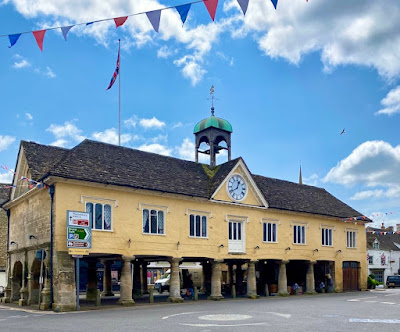Continuity and change
If there’s one building in the Cotswold town of Tetbury that is impossible to miss, it’s the Market House, all seven bays of it, with its upper walls of cream-washed stone, its rows of deliciously plump Tuscan columns, its large clocks, and its bell turret. It was originally built in 1655 as a market for wool and yarn, the main products of the Cotswold Hills in those days, as for centuries before. The building has changed somewhat over the years. It was enlarged in the 18th century and some of the building’s more ornamental features actually date from a remodelling in the early-19th century. The triangular pediments with their clock faces, the hipped roof, and the bell turret all date to 1816–17. At some stage the Market House also acquired the metal dolphins that are displayed on brackets all the way along each of the long walls. These creatures come from the town’s coat of arms and making a pleasant decorative feature that baffles some visitors.
So a building that looks as if it has been here, virtually unchanged, for about 370 years has actually been altered as needs and fashions have changed, reflecting different needs and the wish to make the structure more up to date, or more prestigious. Over the years and at different times it has housed council meetings, law courts, a lock-up for criminals, markets of various kinds, and the town’s fire engine. And its life goes on. Goods are still sold in the sheltered area behind the columns – when I took this photograph, it was rugs and baskets being sold – and the building is hired out for markets, events, and parties. It’s still an important asset to the town, then, though perhaps not as crucial to its economy as in Tetbury’s 17th and 18th-century heyday. If the town today is as much about tourism and shopping as it is about agriculture, the Market Hall still provides a handsome focus for these activities.

No comments:
Post a Comment